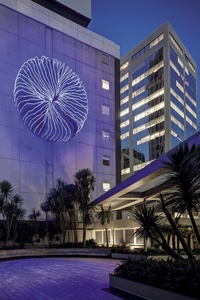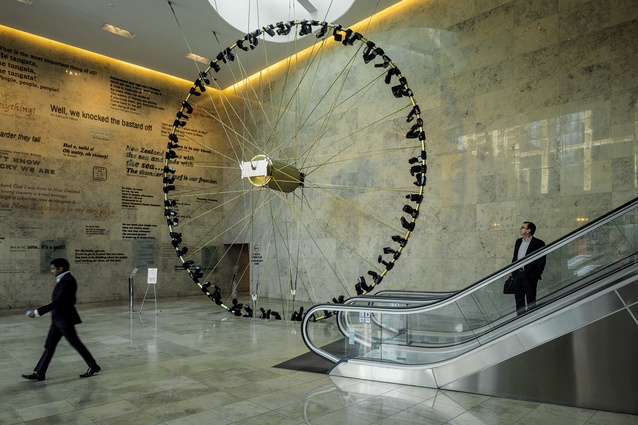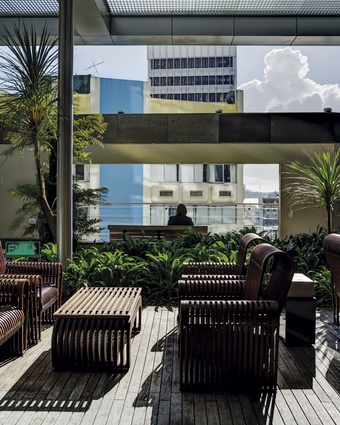Threshold apprehension
I have been watching a lot of Mad Men episodes lately. Aside from the wonderfully flawed characters, it is the representation of early 1960’s corporate culture that I enjoy watching. Spaces are characters within the show, reflecting cultural norms of the time; success is tied to the decorum of the space, the civility of the signage and above all, the presentation of a sculpted image to the street. The advertised corporate image becomes the hallmark of the 20th century and the skyscraper lobby is its spatial equivalent in the public realm.
These towers once presented to corporates a vision of wealth and, through their public spaces, a vision of stability to the public. The way that the public space was manipulated at ground level communicated the tone of the companies that occupied office space above. The exclusivity of a tower address came with the trappings of marble and brass, while the form of the space, at the best of times, indicated a transition zone between the chaos of the street and the order of business. Businesses, in this environment, were trusted institutional members of society and the lobby was the place to demonstrate this most successfully. It was in the lobby that public and private interests came together.

However, 50 years on, the public relationship with the corporation and the tower has changed. The tower has lost some of its sheen. An elongated recession and consistent news of commercial malfeasance has undermined its once-glossy reputation as a symbol of institutional success and strength. The universally held memory of watching the World Trade Centre topple has also had a destabalising effect on our subconsicous consideration of the tower and its place within ‘secure’ captialism. The image of a corporate tower has, as such, become associated not with stability and power, but instead with excess and vulnerability.
Instead of continuing with the tower as a symbol of its brand, many companies are opting to instead adopt more horizontal, campus-like, accommodation for their offices. Buildings of a personable scale, visible social interaction of employees and public spaces from which members of the public can see into workspaces, are the latest marketing images to be facilitated in the architecture of these commercial hubs. Examples from Telecom, ASB and Air New Zealand are but a few of the award winning workspaces that on the whole present an image of colourful friendliness, rather than steely corporate determination. While this change in typology has been advancing, the lobby as the interface between the public and private has remained remarkably consistent. This is in part because the lobby has become the atmospheric benchmark for these new corporate interiors. The blurring of public and private, the possibility of social interaction and the polish of the material fixtures has carried through from the lobby into defining the tone of the current zeitgeist for horizontal workplaces. The lobby, with its acceptance of public oversight and the demand for decorum, is a symbol which some corporations are exploiting in the presentation of their architectural form.
The lobby is as such, a hugely influential space. Not only in the evolution of commercial architecture, but also in their original format within the tower.

It is worth then considering a few of the more successful tower lobby types in our nation’s tallest city. Specifically, it is worth looking at three different lobby formats which exist within the city as typologies in and of themselves. The first notable example is the topographic lobby, as used in the Fay Richwhite Building by Dino Burratini with Peddle Thorpe and Aitken. This lobby is cleverly terraced, addressing the street face as the building turns the corner of Wyndham and Queen Streets. While part of this lobby has been appropriated for retail stores, the remaining portion still demonstrates the importance of the lobby as an, albeit gentrified, extension of the street. The height of the space, combined with its terraces creates an atmosphere that is between the open space of the street and the enclosed space of the tower floorplates.
The second lobby type is that of the laneway lobby, as seen in the National Bank Centre, by Glossop Chan Partnership. Occupying a full city block, the podium for these twin towers holds vast areas of retail space. As such, the tower lobbies become internalised, forming a laneway diagonally across the block. The lobby is a street in this case and a congenial one at that. A glazed roof allows a view up between the towers, while a recent café refit allows members of the public to mingle with those from the towers above. The result being a space which not only facilitates social interaction, but one which is made richer by the placement of the lobby away from the vehicular spaces of Queen Street and Victoria Street.
The third lobby type worth noting is the art lobby. Ubiquitous, but meritoriously achieved in the Vero Centre by Noel Lane Architects. Works by Andrew Drummond, Gavin Chilcott and Gretchen Albrecht are but a few of the artists represented in this lobby. Aside from some of the clever architectural techniques employed it must be said that this foyer is about art, and moreover about the appreciation and facilitation of art by the corporate world. Cynically, this may be seen as an example of the corporate world appropriating a degree of cultural meaning in its interface with the public. But all the same, large commissions for publicly accessible works are a tangible way that private space can give back to the public realm.
All of these lobby types provide value to both the street and the tower – a truly equal public/private partnership. Marble slabs may not have the same connotations as they once did within commerce, but they are still shaping our readings of commercial spaces. In much the same way, tower lobbies are not something that has become irrelevant to the design of contemporary office space. On the contrary, they hold strategies for public interaction and commercial transparency which are now expected from both the boardroom and the footpath.













